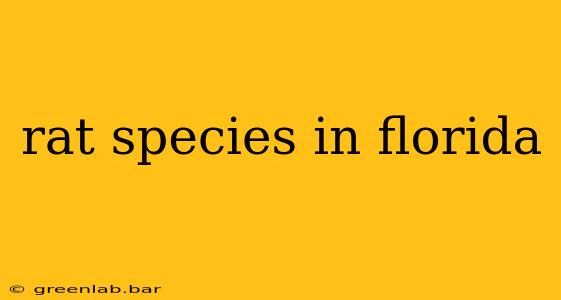Florida's warm climate and abundant food sources create an ideal habitat for various rat species. Understanding these species is crucial for effective pest control and protecting your property. This guide will delve into the common rat species found in the Sunshine State, their identifying characteristics, and the potential problems they pose.
Common Rat Species Found in Florida
Florida is home to several rat species, but two are particularly prevalent:
1. Norway Rat ( Rattus norvegicus)
Often called the brown rat or sewer rat, the Norway rat is the largest rat species found in Florida. They are characterized by:
- Size: Large, typically reaching 10-18 inches in total body length (including tail).
- Color: Brownish-grey fur, with a lighter underbelly.
- Tail: Shorter than their head and body length, thick and scaly.
- Habitat: Prefers burrows in the ground, often near water sources like sewers, drains, and basements. They are also known to build nests in wall voids and under structures.
- Behavior: Nocturnal and highly adaptable, they are known for their strong sense of smell and are excellent climbers and swimmers.
Problems posed by Norway rats: These rats are notorious for spreading diseases (like leptospirosis and salmonellosis), contaminating food, and causing significant structural damage.
2. Roof Rat (Rattus rattus)
Also known as the black rat or ship rat, the roof rat is a more agile and slender species. Distinguishing features include:
- Size: Smaller than Norway rats, typically reaching 7-10 inches in total body length.
- Color: Blackish-grey to brown fur, often with a lighter belly.
- Tail: Longer than their head and body length, thin and scaly.
- Habitat: Prefers higher elevations, nesting in attics, trees, and upper levels of buildings.
- Behavior: Excellent climbers, they are also more cautious than Norway rats and will often avoid direct confrontation.
Problems posed by roof rats: Similar to Norway rats, they spread diseases, contaminate food, and can damage buildings through gnawing and nesting.
Less Common but Still Present Rat Species
While Norway and roof rats are the most commonly encountered, other rat species may occasionally be found in Florida:
- Cotton Rat (Sigmodon hispidus): A smaller, more field-dwelling rat species, less commonly found in urban areas.
- Rice Rat (Oryzomys palustris): Often found in marshy areas and near water bodies.
Identifying Rat Infestations
Several signs indicate a rat infestation:
- Droppings: Dark-colored, rat-sized droppings are a clear sign of their presence.
- Tracks: Small footprints in dusty or muddy areas.
- Gnawing: Evidence of chewing on wood, wires, or food packaging.
- Nests: Made of shredded paper, fabric, and other materials.
- Unusual noises: Scratching and scurrying sounds, particularly at night.
Effective Rat Control Measures
Rat control requires a multi-pronged approach:
- Sanitation: Eliminate food sources by storing food properly, cleaning up spills, and removing garbage regularly.
- Exclusion: Seal any cracks and holes in walls, foundations, and roofs to prevent entry.
- Trapping: Use snap traps or live traps, strategically placed where rat activity is detected. Remember to dispose of trapped rats appropriately.
- Professional Pest Control: For severe infestations, consulting a professional pest control service is advisable.
Conclusion
Understanding the various rat species in Florida is crucial for effective pest management. By implementing preventative measures and employing appropriate control strategies, homeowners and businesses can minimize the risks associated with these rodents. Remember, early detection and prompt action are key to preventing a full-blown infestation.

